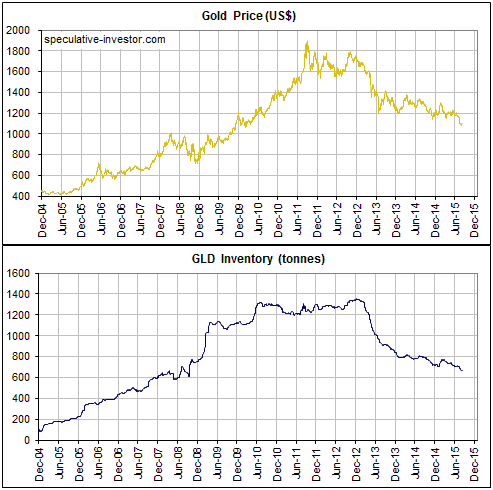Here’s the wrong way to think about gold supply: “Although gold’s aboveground inventory is huge compared to current production, only a tiny fraction of this gold will usually be available for sale near the current price. Therefore, changes in mine supply can be important influences on the gold price.” I’ll now explain the right way to think about gold supply.
Whenever I point out that the supply side of the gold market consists of the entire aboveground gold inventory, which is probably somewhere between 150K tonnes and 200K tonnes, and that the gold-mining industry does no more than add about 1.5%/year to this inventory, an objection I often get is that only a tiny fraction of the aboveground inventory is available for sale at any time. This is of course true, and nobody who has a correct understanding of gold supply has ever claimed otherwise.
If all, or even most, of the aboveground supply were for sale at the current price then the price would not be able to rise. The price can rise and fall by substantial amounts, however, because there is always a huge range of prices at which the owners of the aboveground supply are prepared to sell. Moreover, this range is constantly changing based on changing personal circumstances and assessments of the market. In addition, some holders of existing aboveground gold will be planning to hold forever. These plans, which are themselves subject to change in response to changing circumstances, also factor into the formation of the gold price, in that a decision to withhold X ounces of supply can have a similar effect to a decision to buy X ounces.
As I write, gold is trading in the $1120s. It is therefore certain that a tiny fraction of the aboveground supply is currently changing hands in the $1120s and that there are plans in place to sell other tiny fractions in the $1130s, the $1140s, the $1150s, and all the way up to some extremely high number. Some people will also have plans to sell gold if the gold price falls below a particular level and there will be millions of people who have no specific selling intentions who will decide to sell in the future for some currently unforeseeable reason. At the same time there will be countless plans in place to buy at certain levels and millions of people with no present intention to buy who will, for reasons that aren’t currently foreseeable, decide to buy in the future.
It is the combination of these myriad plans that determines the price. Furthermore and as mentioned above, over the days ahead many of these plans will change. For example, some gold-buying/selling intentions will change based on what happens to the stock market or the bond market.
How does the gold-mining industry fit into the situation?
The gold-mining industry is not materially different from any other seller except that its plans are not price sensitive. Specifically, every year it will sell an amount that’s equivalent to about 1.5% of the total aboveground supply regardless of price. At this time four years ago it was selling gold in the $1800s and it is now selling roughly the same amount of gold in the $1100s. It is the ultimate price-taker. To put it another way: whatever price arises from the changing plans of gold owners and potential owners, that’s the price at which gold producers will sell.
On a related matter, due to the huge existing aboveground supply of gold there should never be a genuine shortage of physical gold. Obtaining more gold should always be solely a question price. A consequence is that the gold market should never go into “backwardation”, that is, the spot gold price should always be lower than the price for future delivery. Just to be clear: in an abundantly-supplied commodity market the futures price should be higher than the spot price by enough to eliminate the risk-free profit that could otherwise be had by selling the physical and buying the futures. That’s why it would be very significant if the gold market were to make a sustained and sizeable move into backwardation. Such a development would indicate that holders of the aboveground supply were withdrawing their gold from the market en masse and/or that the gold futures market was breaking down due a collapse in trust. Even the small and brief backwardations of the past two years have some significance*, although recent gold backwardation episodes have more to do with near-zero short-term US$ interest rates than gold supply/demand. The point is that gold backwardation is only important because the existing aboveground supply in saleable form dwarfs the rate of annual production.
In summary, the price of gold is where it is because of the range of prices at which existing holders intend to become sellers and the concurrent range of prices at which potential future holders intend to become buyers. These ranges are constantly in flux due to changing perceptions and circumstances.
*Keith Weiner has written extensively about the significance of gold backwardation at https://monetary-metals.com/.
 Print This Post
Print This Post







